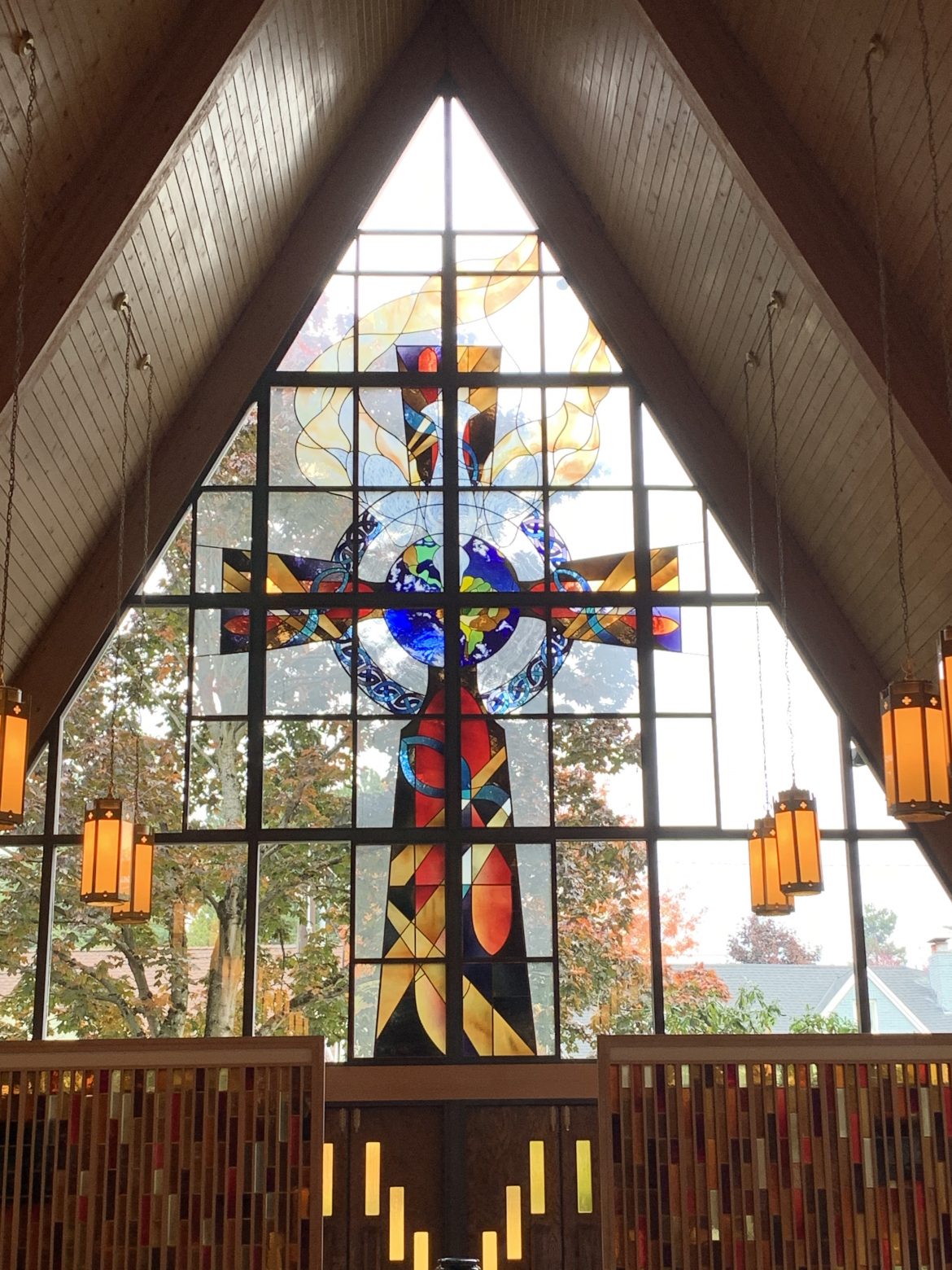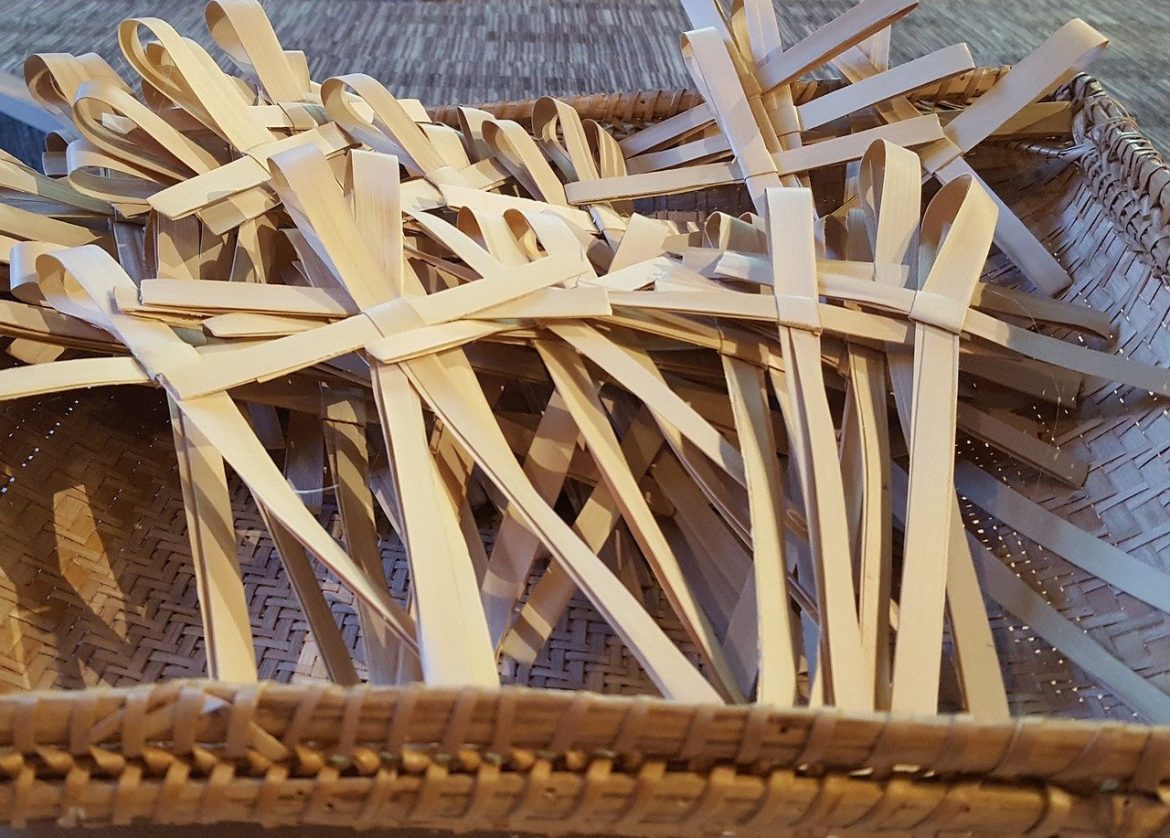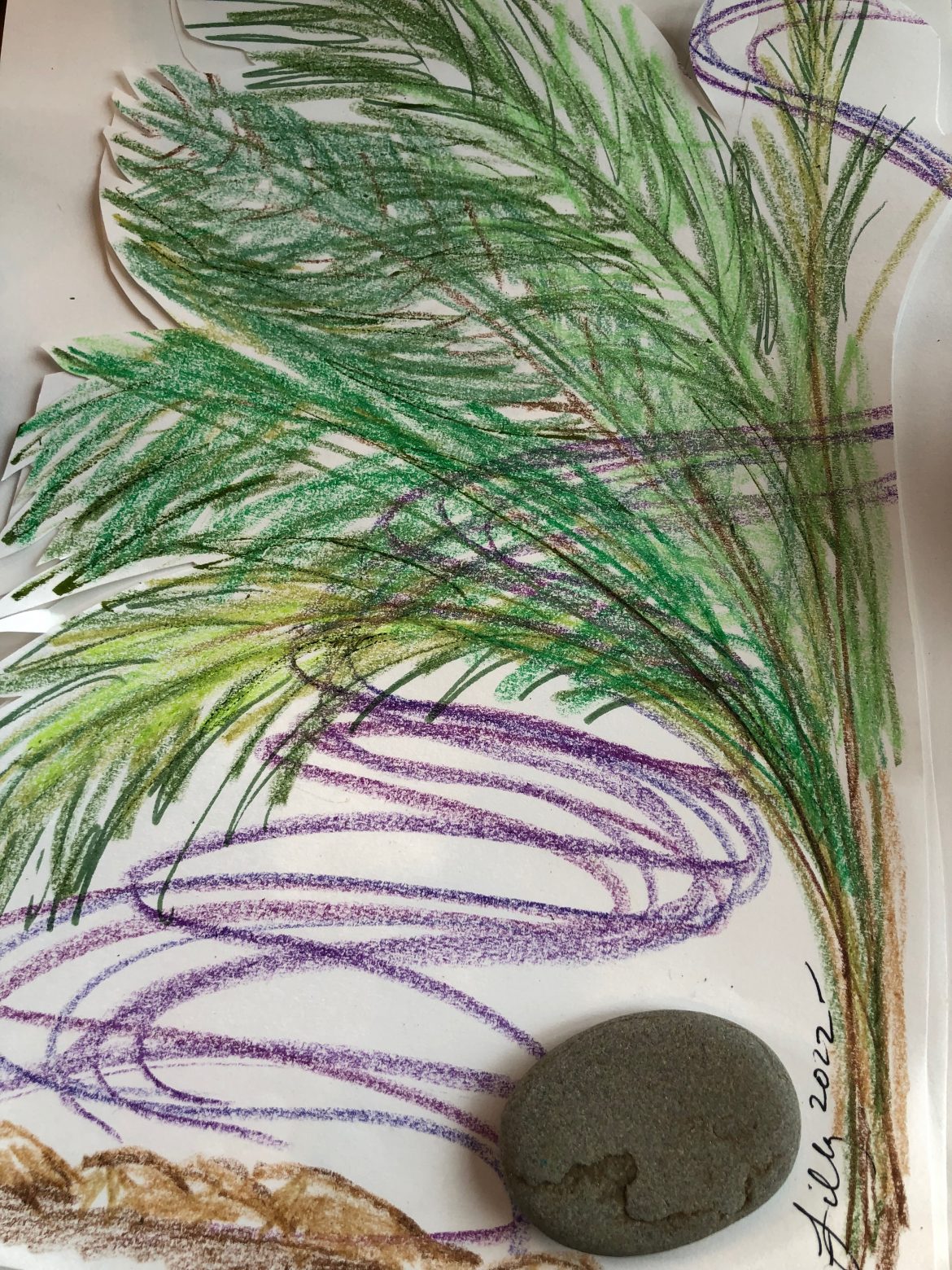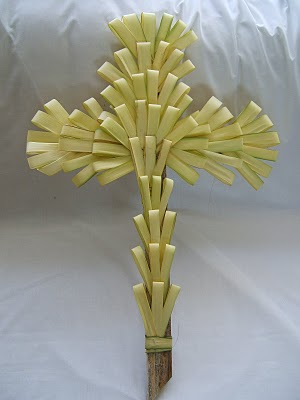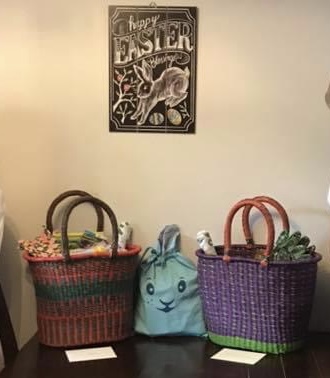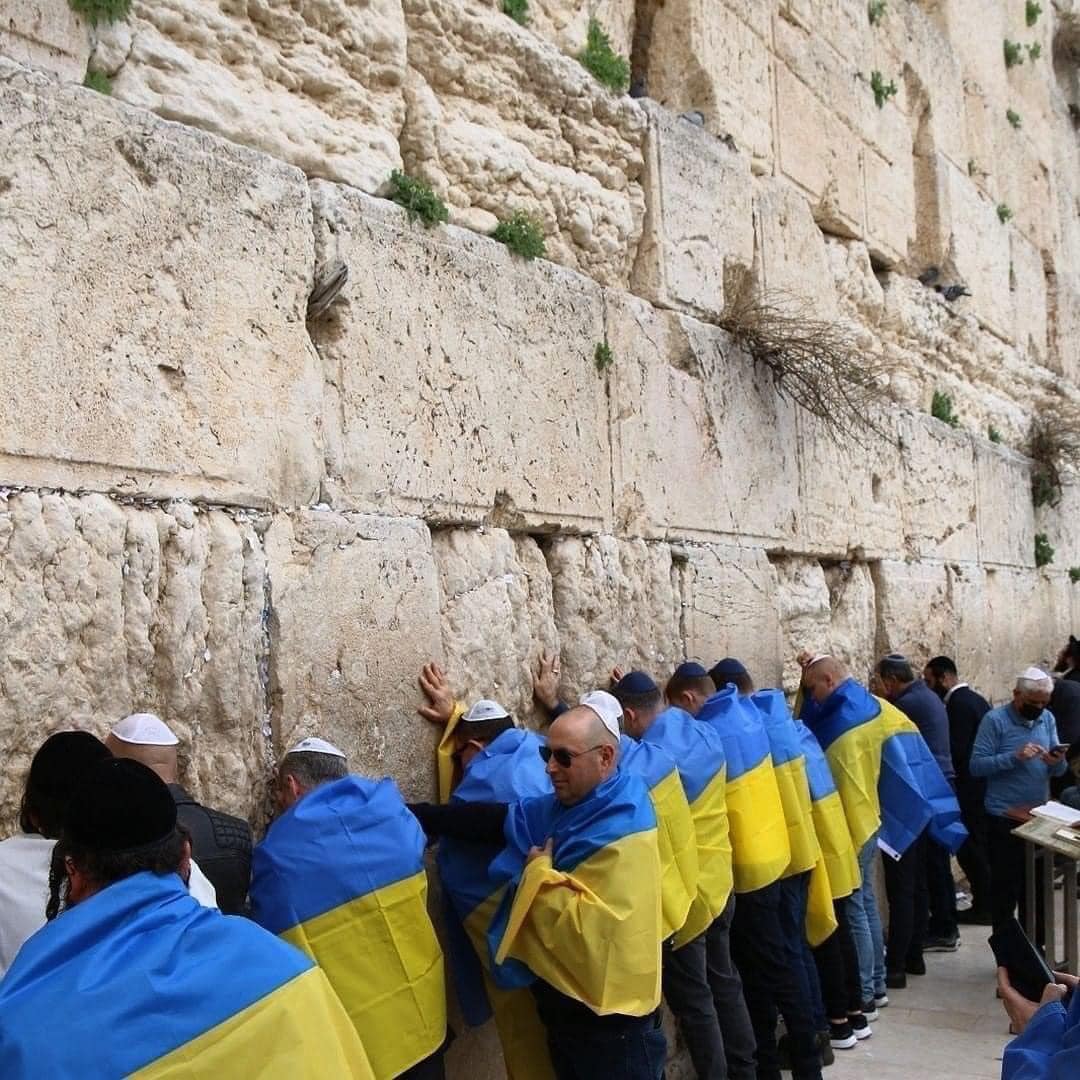An beautiful contemplative service with music in the spirit of Taize for Palm Sunday.
Carrie Grace Littauer, prayer leader, with music by Kester Limner and Andy Myers.
Permission to podcast/stream the music in this service obtained from One License with license #A-710-756 with additional notes below:
“Magnificat”, “Christe Lux Mundi (Christ You are Light)” Copyright and all rights reserved by GIA/Les Presses de Taizé
“Watching, Waiting, Hoping” Music and Lyrics by Kester Limner, shared under the Creative Commons License, Attribution (CC-BY)
“Be Thou My Vision” Traditional Irish hymn, public domain. Arrangement by Andrew Myers and Kester Limner, shared under the Creative Commons License, Attribution (CC-BY)
Thank you for praying with us! www.saintandrewsseattle.org
Perhaps unusually, when I think of Palm Sunday I remember two stories. One is a biblical one – Michal in 1 Samuel 6. Her husband, King David, is returning from a procession where the Ark, the symbol of God’s presence, is finally being returned, carried into the capital. He has danced, exuberantly, with joyous abandon, not a response of duty or kingly restraint, but of openness to God in the freest of worship. But Michal, who has watched the celebration from the isolation of a window, greets him with sarcastic ridicule. There is no celebration for her. Lest we are too quick to judge, hers is a tragic story where she has been the pawn, the victim, of political events in which her husband and father were enemies.
The second is a few years ago when a friend of mine was receiving a series of blessings from God in a season where she was experiencing the Holy Spirit in new ways. I felt on the outside, envious of the sense of closeness to God others seemed to find so easy. I had not meant to be scathing, but clearly something in my attitude reflected my feelings. A good friend, she told me that my stance was hurting her heart. I apologised, and the relationship remained strong, but I retained a sense of looking in from the outside, like the Match Girl glimpsing the beauties others experienced.
And so to Palm Sunday. Again there is a huge celebration as Jesus – the bodily presence of God – is carried into the city. But not everyone can join in. The Pharisees are disturbed, and ask him to rebuke the disciples. Jesus says if they are quiet, the stones will celebrate. Creation must recognise the arrival of the creator – if people don’t, the stones will!
Perhaps we are too harsh on the Pharisees. After all they refer to him as teacher, and they don’t ask him to stop the procession, just to quieten his disciples. Perhaps they were scared it would be deemed an uprising and bring down the wrath of the Romans. Certainly they were concerned to keep the tradition, the laws which they saw not as a means to win God’s approval but as a sign of his love and grace. Whatever the reasons, they cannot celebrate. They love God, want to serve him, but as Jesus is carried into Jerusalem they just can’t join in. And they want to stop the joyous celebration of others
Sometimes even for good people, joy can be elusive. This is a break-out moment. It does not take away from the sadness which will come. Indeed only a few moments later Jesus is racked with sobs over the city he loves which will reject him. Jesus knows this entry is provocative and what will ensue. But biblically celebration and sadness can sit side by side. For a moment we can let go our sadness to celebrate the exuberant goodness of God – his presence in our midst. All worship comes from joy, but a joy forged sometimes from the darkest of places. When there’s ‘pain in the offering’ – as we sometimes sing perhaps too lightly or with too little understanding – there is a profound depth in worship.
Joy perhaps needs to be distinguished from noise. It may include it at times – it clearly did on this occasion – but joy can break out in gentleness even in environments where we are quiet, or through the quietest of personalities. There are sadnesses that no work, no duty, no striving or attempt at denial can heal. But joy is still a possibility. It is a possibility because the king has come. The presence of God is here.
Imagine how different it could have been if Michal could for a moment laid aside the disappointments of her life and made her way down, hitched up her own skirts and danced. If the Pharisees could have left aside their worries about getting it right and joined hands with the children. If you or I could leave aside all the valid and huge concerns of our times and simply, for a moment, enjoy the presence of the King, our extraordinary Saviour.
It can be hard to really open ourselves up to the celebration, the joy of God. It may be personal circumstances, quiet hurts and pains, known or unknown to others. Communion is a good way to again recognise and receive the presence of God into our lives no matter what. Or perhaps we worry about our reputation, or that of the church, or about doing things right. Yet maybe God is calling us to joyous celebration. This is about the heart more than what we do. And certainly, let’s decide we are not going to criticise those who express their joy differently from us, with more or less exuberance. We can celebrate together as we enjoy our differences.
So today let’s open ourselves to the joy of God. He comes to us again: our King and our Saviour.
- https://www.thoughtco.com/little-matchstick-girl-short-story-739298
- Matt Redman Blessed be your name
Photo by Poppyette on Pixabay
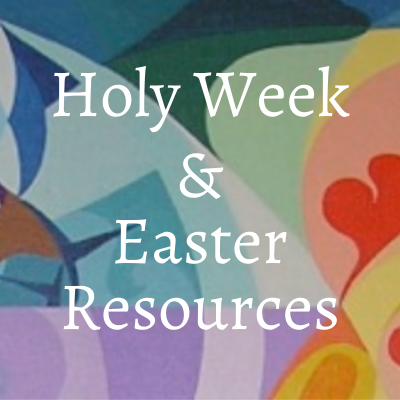 Check out our Lent, Holy Week, and Easter resource page for inspiring posts, helpful products and resources, and gathered lists of liturgies and more to help you plan an Easter service, a solo journey through Holy Week, or a family adventure.
Check out our Lent, Holy Week, and Easter resource page for inspiring posts, helpful products and resources, and gathered lists of liturgies and more to help you plan an Easter service, a solo journey through Holy Week, or a family adventure.
Holy Week is almost here.
And if you are in shock that the Calendar has sped through March and is already deep into April, you are not alone!
As one friend said … I can’t believe it’s Palm Sunday THIS Sunday! And as another friend said at the beginning of Lent, “I’m not doing Lent this year, we’ve been living Lent for the past two years!” This is so true! The layers of Lent, the layers of trauma and exhaustion are many! Thanks pandemic, thanks politics, thanks 24/7 news! And it still grows for some of us daily. We really do need to baby step into Holy Week.
Originally Lent started now … living into the last week of the life of Jesus rather than a whole 40-day fasting experience.
Tradition says that Mary, Jesus’s mom was the first to walk the Way… what became the stations of the cross to remember the suffering of her son.
How can we remember and engage in the Story this week?
You might find some stations of the cross to pray with at your local Catholic Church.
Start with Palm Sunday…
Start by reading Luke 19:28-48
After telling this story, Jesus went on toward Jerusalem, walking ahead of his disciples. 29 As he came to the towns of Bethphage and Bethany on the Mount of Olives, he sent two disciples ahead. 30 “Go into that village over there,” he told them. “As you enter it, you will see a young donkey tied there that no one has ever ridden. Untie it and bring it here. 31 If anyone asks, ‘Why are you untying that colt?’ just say, ‘The Lord needs it.’”
32 So they went and found the colt, just as Jesus had said. 33 And sure enough, as they were untying it, the owners asked them, “Why are you untying that colt?”
34 And the disciples simply replied, “The Lord needs it.” 35 So they brought the colt to Jesus and threw their garments over it for him to ride on.36 As he rode along, the crowds spread out their garments on the road ahead of him. 37 When he reached the place where the road started down the Mount of Olives, all of his followers began to shout and sing as they walked along, praising God for all the wonderful miracles they had seen.
38 “Blessings on the King who comes in the name of the Lord! Peace in heaven, and glory in highest heaven!”
39 But some of the Pharisees among the crowd said, “Teacher, rebuke your followers for saying things like that!” 40 He replied, “If they kept quiet, the stones along the road would burst into cheers!”
41 But as he came closer to Jerusalem and saw the city ahead, he began to weep. 42 “How I wish today that you of all people would understand the way to peace. But now it is too late, and peace is hidden from your eyes. 43 Before long your enemies will build ramparts against your walls and encircle you and close in on you from every side.
44 They will crush you into the ground, and your children with you. Your enemies will not leave a single stone in place, because you did notrecognize it when God visited you.[b]”
45 Then Jesus entered the Temple and began to drive out the people selling animals for sacrifices. 46 He said to them, “The Scriptures declare, ‘My Temple will be a house of prayer,’ but you have turned it into a den of thieves.”47 After that, he taught daily in the Temple, but the leading priests, the teachers of religious law, and the other leaders of the people began planning how to kill him. 48 But they could think of nothing, because all the people hung on every word he said.
- After listening/reading the gospel, picture the scene. Imagine the crowds. What do you see, smell, notice about the things happening around Jesus. How are you feeling? What do you notice? Take some time to consider this and talk to Jesus about how you are feeling. You might journal about this.
- It’s Palm Sunday this Sunday at the start of year three of the Pandemic and as a war rages in Ukraine. Are you cheering today or feeling more like jeering this Palm Sunday? No emotions are wrong. We are loved by Jesus just as we are. Talk to Jesus about where you are today.
- “Hosanna,” an Aramaic word that means “O, save (bring the victory), Lord!” The crowds along the road were looking for salvation from the Empire of Rome. What “elements of empire” would you like to be saved from today? What areas of your life, or problems you see around you would you like to be delivered from today? Talk to Jesus about this.
- How does it make you feel to know that Jesus weeps? He weeps for Jerusalem and for everyone who doesn’t recognize him and the peace He gives. Who in your life needs to know this peace? Pray for these people. Maybe it’s you today! ask Jesus to give you more of his peace and eyes to see Him at work.
- What things are getting in the way of people experiencing God, the church, and prayer? What things need cleansing? What is blocking, or cluttering up your temple court today and separating you from God? Talk to Jesus about this and allow Him to cleanse you!
Notice where you are today.
Be compassionate and curious.
Know that however you are
Up or down
Confused or confident
Jesus sees you & loves you!
Jesus invites you to go slowly into Holy Week and experience his last week with him.
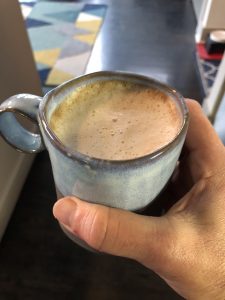
Holy Week with your Cup
Here are some ways to get you started:
You can experience the week with your coffee cup… (explanation here)
I created a way to pray through Holy Week with your Cup. Download the Link here.
PRAY Through the Week with Art:
Palm Sunday Slide Show of Art by James Tissot
Asian and African Art for Holy Week
LISTEN AND WATCH: You might also create your own Holy Week Play List
-
ACTION: Take a walk outside and imagine Jesus arriving in your city or neighborhood. Imagine the streets lined with people cheering. Imagine the city leaders or the leaders of churches getting upset. FIND A STONE/ROCK along your walk to use as a daily reminder to praise Jesus and to remind you to pray for your city & neighborhood.
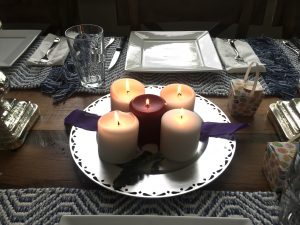
Holy Week Centerpiece
-
CREATE A CENTERPIECE to use throughout the week with your family, friends or on your own learn how in this post with a PDF to print out.
We are invited to walk with Jesus in his last week of life…take a walk and be with Jesus outside…what do you notice? Watch for signs of life. Breathe. Notice the clouds, the sunshine, or stars. Listen to the wind, the birds, even the traffic.
Jesus is with us in all the mess of our lives. In the Message Bible, Eugene Peterson starts the passage before the Palm Sunday/Triumphal Entry into Jerusalem in Luke 19:28 with the heading “God’s Personal Visit.” Jesus came to Earth as one of us, TO each of us and FOR each of us. I am grateful that Jesus knows our pain and weeps with us. I am grateful that Jesus understands our suffering and longs for each of us to know his love and peace.
Jesus, We enter the week slowly with you. Help us to walk with you daily. AMEN
©lillylewin and freerangeworship.com
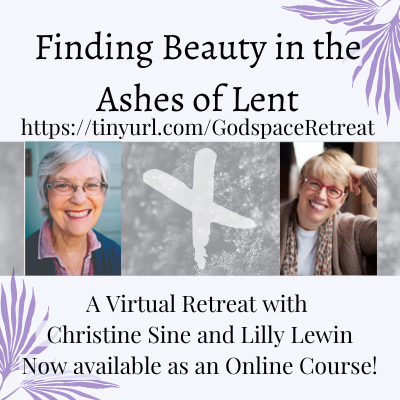 Lent continues, the season is still full of possibility and promise. Are you finding ashes and desiring beauty? Now available as an online course, this virtual retreat will help you to lay out your garment of lament and put on your garment of praise. Gather your joys and release your grief with Christine Sine and Lilly Lewin! Click here for more info!
Lent continues, the season is still full of possibility and promise. Are you finding ashes and desiring beauty? Now available as an online course, this virtual retreat will help you to lay out your garment of lament and put on your garment of praise. Gather your joys and release your grief with Christine Sine and Lilly Lewin! Click here for more info!
Note: This is a repost of Let’s Get Creative With Our Palms
Sunday, April 10th 2022, is Palm Sunday and many from liturgical traditions are already thinking about making palm crosses. We love to process around the church waving our palm fronds. But after the service, the crosses and fronds are quickly discarded and the meaning of the season just as quickly fades from our memories.
This year, you might like to consider doing something creative with those fronds. Don’t throw them out, weave them into larger crosses and Easter symbols that can decorate your sacred space throughout the year as a reminder of this pivotal season of our faith. Then, when Ash Wednesday comes around next year and you want to burn those crosses, you will be able to make a substantial fire.
Here are some inspiring links and Youtube videos that might help you be creative with your own palm fronds.
Catholic Icing shares 10 Things to do with Palms for Palm Sunday. Great ideas for kids to get involved as well.
If you are curious how other cultures around the world celebrate Palm Sunday, take a look at CBC Kid’s.
Minas Thomas has created a whole series of videos on palm weaving from a Coptic Christian perspective that are well worth viewing. He instructs us on everything from a simple cross to braiding of palm fronds and, a more complex Coptic cross and a donkey. Here is the link to the first video:
Here is a beautiful video of a man teaching his grandkids how to make a palm heart, something I definitely plan to try with this year’s palm fronds.
And last, but definitely not least, I also love this video from Michael Nabil – a little more complex and requiring a little construction ability but I would love to give it a go.
More resources for Holy Week:
by Melissa Taft
When my two kids were little, I found myself living in a strange sort of tension around Easter. On the one hand, I did not want to ever take the focus away from the ‘reason for the season’ – Jesus’ sacrifice and resurrection. I wanted that to always be paramount. On the other hand, I am someone with a love language of gifts, an appreciation of tradition, and a desire for my kids to not feel bitterly deprived of fun and rituals around silly or fairy tale traditions. I had grown up with fun and traditions as a firm part of my family heritage, and so I didn’t want to give up altogether on the Easter Bunny. Strange as that may seem, I was concerned that tipping too far one way or another would end up backfiring. I wanted to find some balance. I just personally felt joy in the coloring of eggs and the giving of baskets, and wanted to pass on the fun to my kids.
Yet I was dissatisfied with the idea of celebrating two Easters – a secular and a sacred. To me, the sacred must be paramount, but how could it compete for affection with the allure of chocolate treats and a bunny bearing gifts? Wrestling with that same tension, Christine has put together a resource list for celebrating Holy Week with Kids and another resource list for celebrating Lent and Easter with Kids that have a wide range of ideas, posts, resources, and inspiration.
For my own family, I began to notice the ways I was already using secular symbols or rituals to point to the sacred. Gifts were already a spiritual practice in our home, and I already felt quite confident about our Advent/Christmas season being a blend in ways that maintained the focus I wanted. Nature afforded ample examples of the fingerprints of God and ways to know Him. Scripture was already brought into ‘everyday’ situations. So I set about dreaming and praying about how to make that happen, and an Easter basket tradition was born.

I took the traditional secular symbols of Easter and looked for how they represented the sacred. Even the Easter Bunny has stood in for some spiritual principle or a Bible verse over the years – from God giving good gifts to His children to delighting in creation to celebrating creativity and imagination and more. I used eggs to represent the Trinity, new life in Christ, spiritual and creation renewal, environmental care, and more. Even the candy had an idea or a verse tied to it – the easiest one being “taste and see that the Lord is good!” – Psalm 34:8 For example, one year I used various Easter/nature symbols to illustrate the transformative power of the resurrection. Instead of a typical basket, I used flower pots to hold the treasures which included wooden butterfly stages toys I’d bought handmade and actual butterflies to add to a butterfly habitat we had. Well, the caterpillar form anyways! Flower seeds to represent growth and transformation as well, an egg I’d made to add to their kitchen toy collection to represent the trinity, a headband with a lamb to represent the lamb of God and how that sacrifice covers our sins, a wordless book I’d made, and other treasures.

This also gave me some opportunities to think outside the box with the baskets and revelries, and to do my best to honor my own buying principles. Instead of heaps of candy, I often opted for a few quality pieces that were fair-trade and ecologically conscious – or at the very least, limited to one type of ‘regular’ candy. I found baskets on my local Buy Nothing group that I reused – when I wasn’t being clever with the ‘basket’ that is. I bought shredded paper that I reused instead of the plastic grass. I even found some biodegradable Easter Eggs! Sometimes items were thrifted. I had a lot of fun over the years coming up with themes and finding items that my kids would use and enjoy but did not betray my principles and illustrated the sacred.
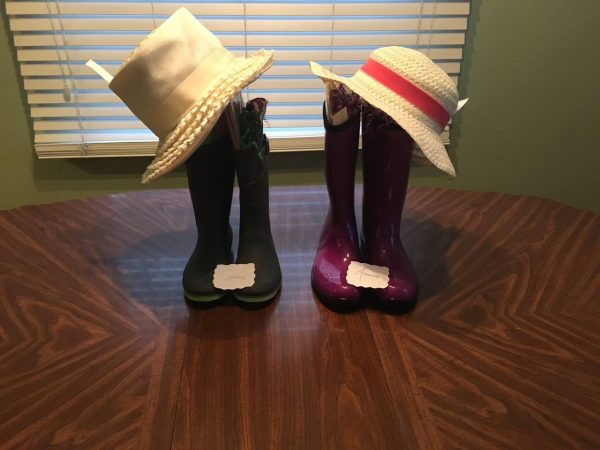
As they grew, the themes matured as well. One year it was all about the armor of God – new needed boots to represent the feet shod with the Gospel of Peace, vintage second-hand bought hats to wear on Easter and other occasions to represent the helmet of salvation, special necklaces to represent the breastplate of righteousness, etc. The top photo’s theme included tools for Christian life, and the baskets themselves were sturdy fair-trade market totes. Another year we were going on a long trip via plane, train, and automobiles and they needed luggage so I used Easter as a chance to budget travel items we needed in and made the theme about taking God with you wherever you go, as He is already there. One year it was new umbrellas (His Banner over Me Is Love/Protected Under His Wings) filled with other promises and admonitions – bubbles to represent the Holy Spirit, a duck given via World Vision to represent feeding the hungry, fishy crackers since we are to be fishers of men, and more.
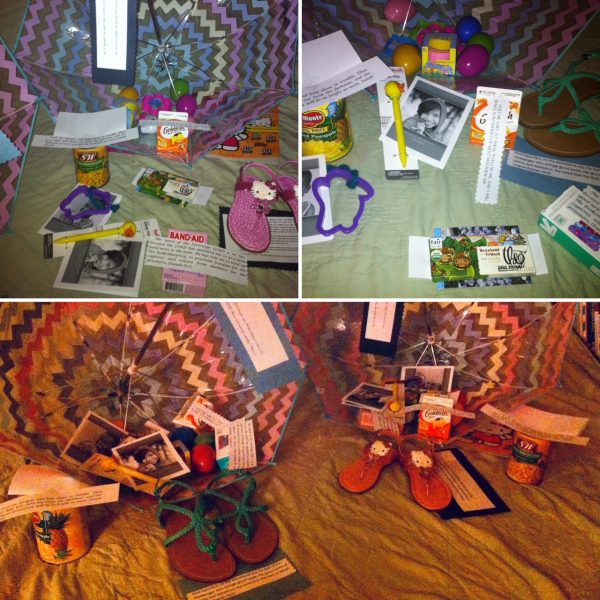
Whether a can of food, a pair of shoes, or even the Easter Bunny – it is possible to point the way to Christ. The secular is but a thin veil to the sacred. I hoped to encourage my children to love not only in words but also in deeds, and to see that Easter belongs to Jesus. Just as everything in creation does.
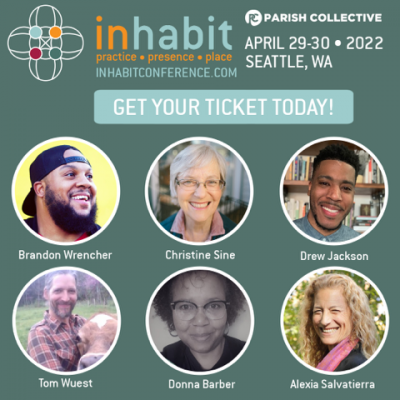 Join Christine Sine, Tom Sine, and others for Inhabit 2022 on April 29-30th in Seattle- a live conference by Parish Collective. Explore stories of hope and be encouraged to be the church in your neighborhood. You are not alone – the everyday realities are carried by us all. Click here for more info!
Join Christine Sine, Tom Sine, and others for Inhabit 2022 on April 29-30th in Seattle- a live conference by Parish Collective. Explore stories of hope and be encouraged to be the church in your neighborhood. You are not alone – the everyday realities are carried by us all. Click here for more info!
originally posted on our partner Circlewood’s blog, The Ecological Disciple, here. Above photo: SYNERGY, 2009, LAKE WANAKA, NEW ZEALAND
When viewing the work of collaborative artists Martin Hill and Philippa Jones of New Zealand, the precariousness of the art may be the first thing you notice. As with other environmental artists, including Andy Goldsworthy, who I have written about in the past, the viewer often wonders, “How did they do that?” In addition to the precariousness of the design, there is a precariousness in its very existence; the work is temporary, often with photographs being the only lasting record of its existence.
The Shape of Time
The temporary nature of the work parallels how these two artists see their world and their work. Their art has much to say about the way we live in this world and the changes we need to make to live better within it.
Given that the earth is fundamentally a circular system (consider seasons, the water cycle, the cycles of plant life), the things that last are those that are sustainable. In natural systems, which have developed over time, things either adapt or die, depending on whether they are sustainable or not. If something is sustainable, it takes only what it needs from the natural system and eventually returns those things back into the system. All of nature itself operates in this same sustainable, cyclical pattern—a self-sustaining system, one that humanity essentially adhered to until recent times.
Industrialization, however, has brought about a different way of living. With its dominant view of time as linear, modern practice mostly disregards cyclical sustainability, using resources without concern for either what is being taken from earth systems or what is being put back into those same systems. Progress, rather than sustainability is the driving mindset, with short-term goals such as the extraction of resources or the success of a particular project being the sole focus.
…the aim of human industrial design is money and instant effect. It travels the shortest distance between wanting and making; and when wanting fades and making proves imperfect, the product is cast aside and the voracious appetite of humanity pushes onward, making more and more things, using more and more resources, creating more and more waste. Such a design process is called a linear system and it follows a take-make-discard model of production. [1]
This linear perspective sees time as a strict movement forward, with no need or desire to circle back, but only progress from a distinct beginning toward a future end, supposedly better and distinct from what has been.
This perspective tends to devalue the present, seeing it only as a stepping stone to the future. The earth itself can be disregarded within this mindset as it is reduced, in the economic point of view, to a mere conglomerate of resources to be used, or in the overly spiritual point of view, as an insignificant waypoint on the route to heaven. Neither of these views values the earth itself as a gift from God which we are meant to love, nurture, and protect, and neither view fosters sustainability.
It can be difficult to change a mindset we are immersed within. How difficult is it for you to look at time from a cyclical viewpoint instead of a linear one? Do you think this changes how you view issues of sustainability?
The Shape of Systems
The disconnection between the human system and the natural system can be seen as humans both suck up tremendous amounts of limited resources and also dispel waste that cannot be absorbed healthily back into the natural system. The art of Hill and Jones spotlights this difference between the destructively linear human systems and Nature’s restorative cyclical systems.
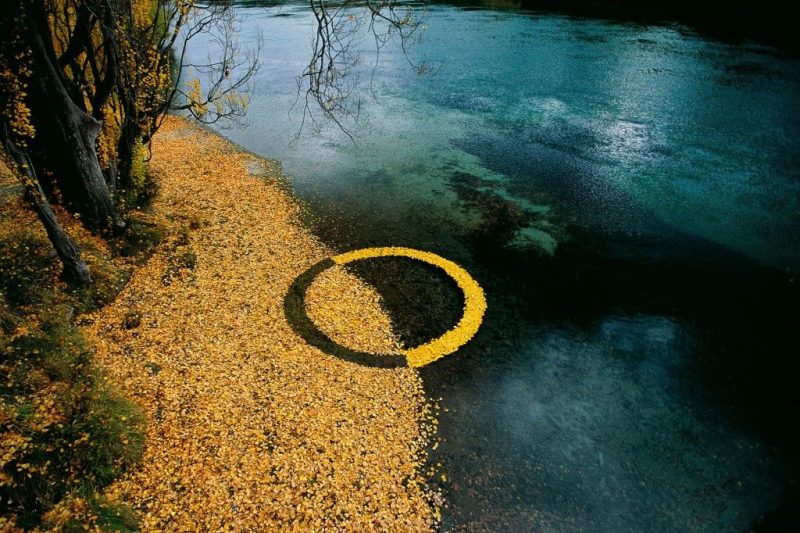
AUTUMN LEAF CIRCLE, 2010, CLUTHA RIVER, WANAKA, NEW ZEALAND
This value of sustainability is present both practically and thematically in the art they create.
Practically, the materials they use are from the natural environment and when the sculpture is complete, it is “returned to nature, thereby mimicking natural systems that operate without creating waste. Everything dies and becomes food or energy for something else.” This creates a closed loop design consistent with the circular pattern of sustainability which natural systems are based on. Nothing is wasted.
Thematically, sustainability is addressed through the specific meanings that Hill and Jones connect to the shapes they use in their sculptures. Knowing the language of those shapes—what each shape represents—deepens the viewer’s experience and understanding of the art. Spheres and discs typically represent the earth, with its natural cyclical cycles. The spiral represents growth and the infinity symbol represents continuous flow or eternity. Straight-sided forms such as triangles, diamonds or squares represent human technology and man-made systems.
Their art shows both the aesthetic and practical beauty of these systems working harmoniously, and particularly emphasizes the necessity of human systems fitting themselves within the natural systems that exist. You can see the aesthetic beauty of this when you see works such as the one pictured below. The placement of a semicircle upon a reflective surface, such as a lake, turns the surface’s reflection into the other half of that semicircle. The result is complete circle, a joint art project on sustainability in which one half of the project is man-made and the other half is nature-made. In a sense, this partnership creates the complete work work of art.

The interplay between man and nature is portrayed symbolically in artwork such as the sculpture, “Solve for Pattern,” which is pictured below. By placing a diamond (representing man) within a circle (representing nature), the artists are showing through metaphor that human systems must adapt themselves and fit within the natural systems around them.
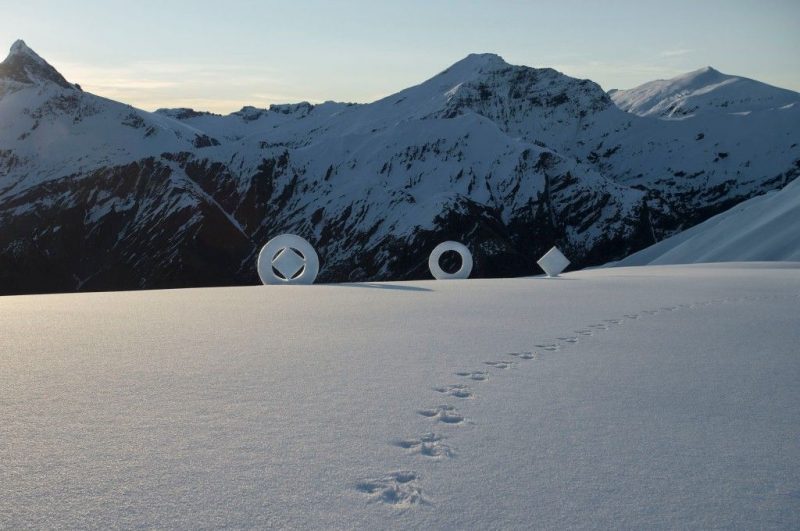
What can you do to create less waste and consume fewer unneeded resources? Are there ways in which you intentionally adapt to fit within the earth’s natural systems? Are there ways in which you perhaps unintentionally disregard the earth’s natural systems?
Giving a Better Shape to Humanity
In their recent work, a human shape has begun to appear in many of the pieces. This is due to the realization that we have entered what is being called the Anthropocene era—a time in which humans are the species with the most dominant influence on earth.
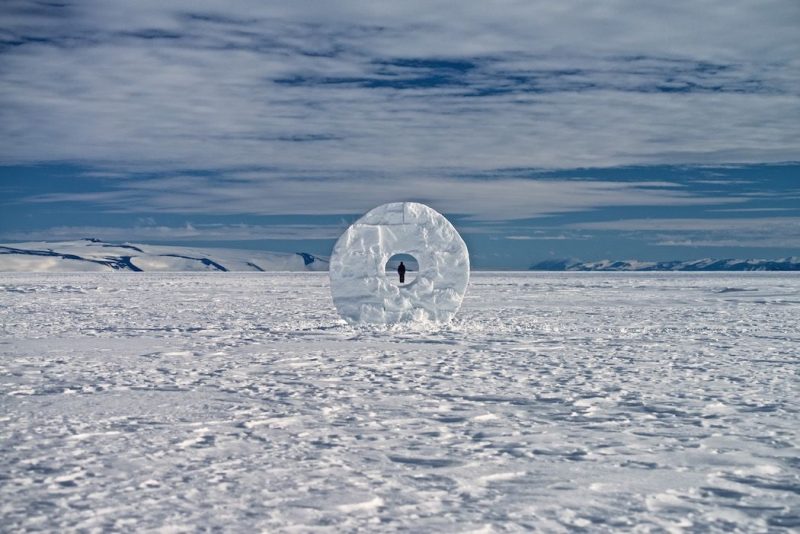
As the species having by far the largest effect on the earth, we are also the species capable of changing the ecological trajectory. Humans can be either guardians or destroyers, a truth represented in these sculptures through the inclusion of the human figure. Below, marsh reeds create an outline of a person’s figure, and the title, Wetland Guardian, highlights the positive role man can and must take on if the planet is to recover its equilibrium.

It is interesting to think about how we view our own personal legacy. Often when people want to leave a mark on the world, it has to do with leaving a signpost of their own existence. It is interesting to consider what it might mean to approach this more humbly, with more of a sustainable, cyclical mindset – for me personally, our parent organization, Circlewood, continues to help my thinking in this area. What might it look like to have a positive, sustainable effect on the world you are a part of?
Hill and Jones continue to work to bring about change in how we view the world. After 25 years, they recently completed a project called the Fine Line Project, which emphasizes the connectedness of the earth through a symbolic line that ties together 12 environmental sculptures that they placed in remote locations such as Madagascar and Antarctica. The “line” encircles the globe, bringing home the reality that all the locations of the sculptures (and all the places in between) are part of a connected whole, the circle of the earth we live on.
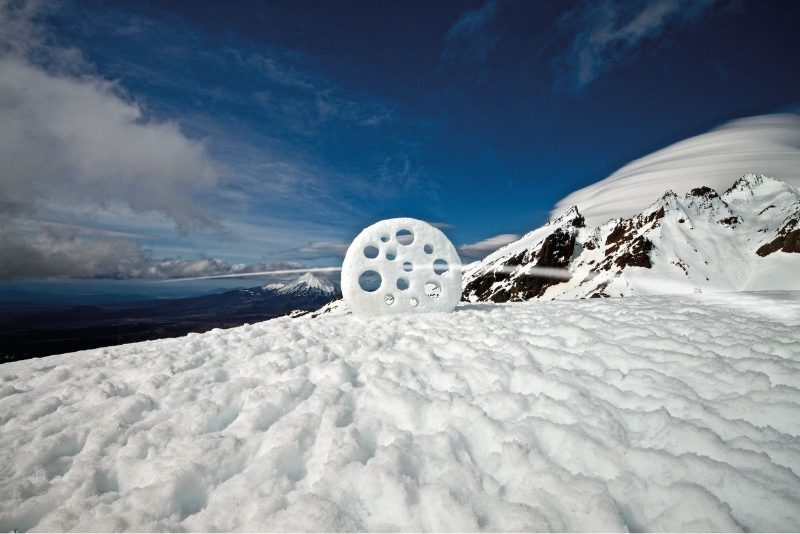
SCULPTURE NO.12, MT. RUAPEHU, NEW ZEALAND 2019
To learn more about Martin Hill and Philippa Jones and see more of their work, visit Martin Hill’s website.
Feel free to contact me directly at info@circlewood.online. – Louise
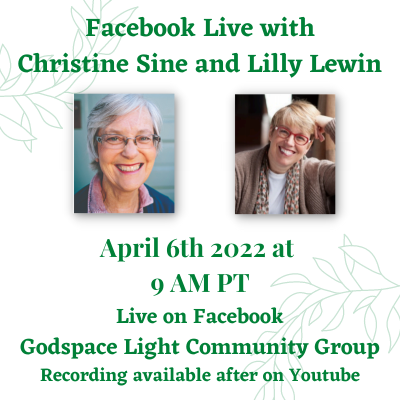 Tomorrow! Wednesday, April 6th, join Christine Sine and Lilly Lewin for a discussion on the injustice of Holy Week. Live on Facebook in the Godspace Light Community Group at 9am PT. Can’t join us live? Catch it later on youtube!
Tomorrow! Wednesday, April 6th, join Christine Sine and Lilly Lewin for a discussion on the injustice of Holy Week. Live on Facebook in the Godspace Light Community Group at 9am PT. Can’t join us live? Catch it later on youtube!
“We are born knowing how to cry, but it takes another to teach us how to cry well and with purpose” “Your wails are meant to be heard” (This Here Flesh , Cole Arthur Riley, 106)
When I read this in Cole Arthur Riley’s inspirational book over the weekend two images came to mind. One was of the Jews praying at the Wailing wall in Jerusalem, particularly this photo which has been circulating around Facebook over the last week. The second image was of Jesus praying in the garden of Gethsemane just before his betrayal.
It suddenly hit me – Jesus prayed tears of blood. That is pretty forceful weeping, and I imagine that just like at the Wailing Wall, his prayers were not silent but loud with wailing and deep emotion as he howled in pain and sorrow. He wept with the pain of a tortured soul crying out to God. Not, I suspect, because he was afraid to face the agony of the sacrifice he knew was coming, but because he did not want it to be necessary. He wept out of love for a world that he knew was meant to be good and beautiful and loving and yet was so badly broken that it required the sacrifice of God to bring it healing and wholeness.
As Jesus begins this last agonizing journey of lament, I can see him crying tears of agony for the people of Ukraine, and Myanmar, of Sudan and Ethiopia and Afghanistan. I can see him crying for every despised and abused Black person, and LGBTQIA person, so many places and people that still call for his deep soul-wrenching lament of blood-like tears. I also see him crying for the earth that groans under the weight of pollution and destruction, weeping tears of blood for us who are meant to be loving and caring and yet are not.
Then I am hit again. How could the disciples sleep through that kind of praying? How could they not be out there praying and weeping blood like tears with Jesus, consumed like he was by the horrors of the brokenness and suffering of the world around them? Perhaps, they stayed awake for a short while, boosted by the adrenaline of the exciting Passover meal they had just enjoyed. But they were really looking for a king very much like the Roman emperor. A God who wailed and howled and wept at the extent of pain and suffering in the world just put them to sleep.
Would we sleep through that kind of praying too? It seems to me we do that every time we turn our backs on someone who is suffering and in pain, and every time we are indifferent to the growing pollution and impact of climate change around us. “Their wails are meant to be heard.” And yet we like the disciples seem so often to be asleep.
I can’t believe it has taken me almost 50 years of following Jesus to recognize not just the incredible agony of Jesus weeping in the garden but also its reason. And I cannot believe it has taken me just as long to recognize myself in the sleeping disciples. The significance of Jesus weeping in the garden of Gethsemane should be just as important to us as his crucifixion and resurrection are. His disappointment at our inability to stay awake with him is so vivid. Why can’t my followers enter into the pain and suffering of this world as much as I do he seems to be saying. Why don’t they have the depth of courage and the same passion of their convictions I do.?
Next Sunday is Palm Sunday, and we all see ourselves shouting Hosanna and waving palm fronds as we rejoice with Jesus and his triumphant procession into Jerusalem. But it is not long before the atmosphere changes and many of us are no longer shouting Hosanna to the king, but “crucify him,” and I wonder if our indifference to the depth of Jesus’ agony in Gethsemane and its importance for the new world God is giving birth to is the place that we lose him. We have such short attention spans, especially when it comes to pain and suffering. We want to join Jesus in his joy filled moments but not accept the pathway of pain that we often must pass through to find that joy.
So what can we do to wake ourselves up?
First we need to join Jesus in the Garden of Gethsemane and face up to the depth of pain God experiences every single day because of the suffering of our world.
Second we need to commit to staying awake to the suffering around us. Not just for a few moments but every day, all day. Sometimes we fall asleep because we deliberately close our eyes to pain and suffering and I am concerned that when another tragedy catches our attention we will forget about Ukraine and all the other suffering places in our world. Yet this is the God we follow and through the example of Jesus, we are shown exactly how radical following this God is.
Third we need to walk together with those who are already on this pathway as well as those who are struggling to stay awake. The older I get, the more upset I become about the injustice and pain in our world and the more I want to make a difference – even if it is only through writing and challenging others to walk with me. I thank God every day for the diversity of voices that are rising around me – for the Black and Hispanic and Indigenous voices. For the LGBTQIA persons, and the growing number of eco theologians and Christian environmentalists.
So as you get ready for Holy Week, I pray that you too will be prepared to stay awake with Jesus in the garden and fill yourself with the same passion he has for those suffering in our world.
 Journey through Lent with this downloadable bundle featuring Prayer Cards, 40 Daily Ideas Guide for Lent, and our Lenten devotional – A Journey Into Wholeness: Soul Travel from Lent to Easter. Bundled together for convenience and savings!
Journey through Lent with this downloadable bundle featuring Prayer Cards, 40 Daily Ideas Guide for Lent, and our Lenten devotional – A Journey Into Wholeness: Soul Travel from Lent to Easter. Bundled together for convenience and savings!
As an Amazon Associate, I receive a small amount for purchases made through appropriate links.
Thank you for supporting Godspace in this way.
When referencing or quoting Godspace Light, please be sure to include the Author (Christine Sine unless otherwise noted), the Title of the article or resource, the Source link where appropriate, and ©Godspacelight.com. Thank you!

